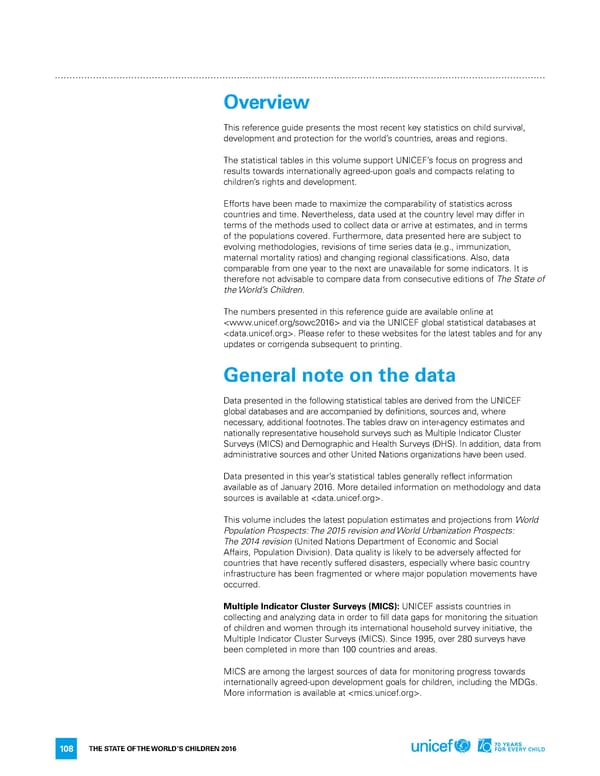Overview This reference guide presents the most recent key statistics on child survival, development and protection for the world’s countries, areas and regions. The statistical tables in this volume support UNICEF’s focus on progress and results towards internationally agreed-upon goals and compacts relating to children’s rights and development. Efforts have been made to maximize the comparability of statistics across countries and time. Nevertheless, data used at the country level may differ in terms of the methods used to collect data or arrive at estimates, and in terms of the populations covered. Furthermore, data presented here are subject to evolving methodologies, revisions of time series data (e.g., immunization, maternal mortality ratios) and changing regional classifications. Also, data comparable from one year to the next are unavailable for some indicators. It is therefore not advisable to compare data from consecutive editions of The State of the World’s Children. The numbers presented in this reference guide are available online at and via the UNICEF global statistical databases at . Please refer to these websites for the latest tables and for any updates or corrigenda subsequent to printing. General note on the data Data presented in the following statistical tables are derived from the UNICEF global databases and are accompanied by definitions, sources and, where necessary, additional footnotes. The tables draw on inter-agency estimates and nationally representative household surveys such as Multiple Indicator Cluster Surveys (MICS) and Demographic and Health Surveys (DHS). In addition, data from administrative sources and other United Nations organizations have been used. Data presented in this year’s statistical tables generally reflect information available as of January 2016. More detailed information on methodology and data sources is available at . This volume includes the latest population estimates and projections from World Population Prospects: The 2015 revision and World Urbanization Prospects: The 2014 revision (United Nations Department of Economic and Social Affairs, Population Division). Data quality is likely to be adversely affected for countries that have recently suffered disasters, especially where basic country infrastructure has been fragmented or where major population movements have occurred. Multiple Indicator Cluster Surveys (MICS): UNICEF assists countries in collecting and analyzing data in order to fill data gaps for monitoring the situation of children and women through its international household survey initiative, the Multiple Indicator Cluster Surveys (MICS). Since 1995, over 280 surveys have been completed in more than 100 countries and areas. MICS are among the largest sources of data for monitoring progress towards internationally agreed-upon development goals for children, including the MDGs. More information is available at . 108 THE STATE OF THE WORLD’S CHILDREN 2016
 70 Years for Every Child Page 126 Page 128
70 Years for Every Child Page 126 Page 128